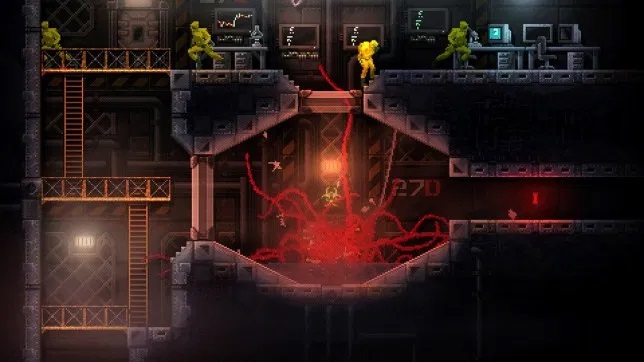
Carrion is a new Metroidvania game from indie developer Phobia Game Studio. You are fast-moving, utterly vicious monster on the loose in a remote science facility. Carrion delights in taking the tropes of the genre — power creep, exploration and backtracking — and turning them on their ear in ways that are surprisingly effective.
One (1) squiggly boi
In the early game, it’s unclear if freedom is the monster’s goal. Blood is your only currency, movement your sole desire. Your many-tentacled avatar stalks and consumes human foes, some of whom are armed, many of whom are not, to increase its biomass. Increasing your biomass — which is to say increasing your physical size and overall health pool — comes at a price. Though it makes you more powerful, your maneuverability is greatly diminished. For instance, you may be able to reach objects and enemies that are further away when at full capacity, but your size means can no longer squeeze through small gaps. Consuming human foes is a visceral experience. Your searching tendril yanks them off their feet and into the darkness. Their terrified screams are cut short and their blood sprays the surrounding geometry as your hundred mouths chew up their bodies. To say the game isn’t for the faint of heart might be to undersell it. If horror isn’t your thing, specifically inflicting the horror in question, then perhaps consider playing something else.
The monster uses the innards of the facility to move about largely undetected, and this is where Carrion most effectively deploys its influences. The monster can hide in the walls and roar to distract fearful guards, and it can slither through pipes and crawlspaces to access new areas. As it goes, it can spread its biomass to create save points, corrupting the surrounding facility. From time to time, you’ll come across cannisters in laboratories that, when broken, release a cloud of spores into the air. Entering the spores grants a new power or ability. What began with a simple projectile spiderweb for sticking enemies to walls quickly moved into things like wall smashing and enhanced sonar. All of your powers are used in concert to smash through seals that keep each area of the facility contained from one another.
Looks real bad in there
Visually, Carrion does a lot with seemingly very little. Its SNES-era palette belies some truly fantastic animations. The way the monster uses its many tentacles to move smoothly about, slithering into small spaces and moving quickly from cover to cover is unsettling. There’s a menace in the way it moves, filling unlikely spaces the way water fills a plastic bag., waiting to strike. The moments when it feasts on the bodies of its foes are deliberately confused, a mess of red pixels and mouths all moving together.
Enemies react in fairly predictable patterns. Unarmed foes tend to run for the farthest corners of the room as they hear you skitter around in the ducts. Those with weapons try to keep a bead on you and anticipate places you might break into the room. Armoured foes actively advance toward you when they hear you, and cannot be consumed due to their hardwearing clothes. All of these things can be exploited with your moveset. Foes with guns can be restrained with spiderwebbing or yoinked with your long, seeking tendril. While unseen, you can roar and shake the walls to send enemies into a panic or herd them into corners more easily accessible. From there, you feast.
Monstrous design
In the same way that Carrion wants to flip the monster-loose-in-a-facility trope on its head, it also seeks to subvert the Metroidvania genre. For one thing, there’s no map. Why would your creature have one? The reason for this is actually fairly simple — Carrion isn’t a very long game. You can knock it over in four or five hours, which means there aren’t that many places to visit. Additionally, new paths forward aren’t ever very far away once unlocked. Traversal from area to area is often conducted via one-way pipes. The pipes tend to push you in the right direction, making it easier to remember where you were and how to get back. This subverts genre expectations entirely. The lengthy playtimes and knotted, interwoven maps that are considered core to Metroidvania design are nowhere to be found.
The obvious downside to this is that the game becomes repetitive quite quickly. Because it’s only five hours long, it never completely wears out its welcome but it’s easy to see why Phobia wasn’t willing to expand its scope any further. The devs had their whiteboard full of good ideas and it feels like they got them all in the game. For all its excessive gore and over-the-top staging, standpoint, Carrion‘s design is quite restrained. It knows what it wants to do, it ticks those boxes, and then it rolls credits. I respect that a great deal.
Final thoughts
Carrion is a solid way to kill a rainy afternoon in lockdown. It focuses on being more of a thrilling, visceral experience than it does outright challenge, and that’s perfectly fine. It winks at genre conventions and has a good time exploring ways to subvert them. Its hyper-stylised violence may be too extreme and visceral for some. Those who can stomach it’s grosser predelictions will be rewarded with a bloody romp from a very confident studio.
![]()
![]()
![]()
![]()
![]()
FOUR STARS (OUT OF FIVE)
Highlights: Solid Metroidvania gameplay; Short and sweet; Some great ideas
Lowlights: Becomes repetitive late in the game; Violence may be too gory for some players
Developer: Phobia Game Studio
Publisher: Devolver Digital
Platforms: Windows PC, Nintendo Switch
Available: Now
Review conducted on Windows PC with an pre-release code provided by the publisher.
